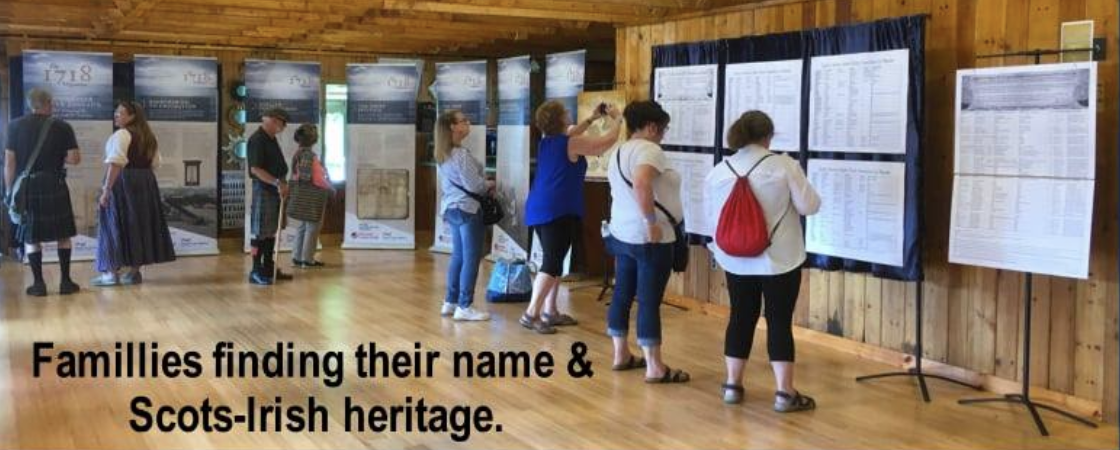Scotland and Ulster
Although migrations had been ongoing for thousands of years, the early seventeenth century saw 20–30,000 cross the North Channel into Ireland from Scotland and the border region of England for a variety of reasons. At the narrowest point, only 13 miles of sea separate Ulster (northern part of Ireland) and Scotland, a mere three-hour sail.
The early 1700s witnessed a significant outflow of Scots-Irish from Ulster caused by economic pressures, particularly rack-renting and tariffs imposed on the linen industry, and agricultural challenges due to poor harvest and drought led to periodic famines. The Test Act of 1704 meant that Presbyterian ministers could not conduct marriages, baptisms, or hold public office.
At the same time, leaders of Massachusetts were seeking new settlers to form a defensive barrier north of Boston. The Scots-Irish made superb frontiersmen. Their experiences in the Scottish Borders and decades of fighting their neighbors in the north of Ireland had created a race of hardy unyielding people who were ideally suited to tame a new frontier. The offer of a new life in rich and fertile surroundings persuaded many to risk the hazardous ocean crossing in search of affordable land and religious freedom.
Scots-Irish in Maine
In 1718, a mass exodus began from the Foyle and Bann Valleys of Ulster bound for New England. After a harrowing journey at sea, they landed in Boston. In late August, two ships with Reverend Woodside and Reverend McGregor were encouraged to sail north to the frontier in what is now present day Maine. The ship ‘MacCallum‘ passengers disembarked near Brunswick on Merrymeeting Bay. McGregor’s ship, the ‘Robert’ was frozen into Portland harbor for the winter. When spring arrived, a few of these families left for New Hampshire, but many more stayed in Maine.
“The promise of a new hame” - John Mann
This Scots-Irish migration starting in 1718 formed the backbone of many Maine communities and the culture that they brought with them has been, over time, woven into the fabric of everyday American life. It has been passed down to us, in a thousand ways, through the centuries. Their influence can be found in our legal systems, local control preference, relationships to the land, and dry Maine humor.
Members of MUSP and its many friends have combined known family histories with many published sources to provide brief family digests available on our website.
About MUSP
The Ulster-Scots story in Maine and their influence on New England has been greatly overlooked by the traditional historical narrative. U.S. census data 2020 confirms that Maine has, per capita, the highest percentage of self-identified Scottish and Scots-Irish descendants in the entire USA.
Our mission is to promote awareness of Maine’s Scots-Irish heritage and to gather, save, and share the stories of Maine’s Scotch-Irish families.
Please continue to explore our website where you will find: Information about MUSP, News & Events, 1718 Migration Information, Genealogy and Video links, Archaeology Projects & Updates, Ships & Scottish Clans List, and over 200 individual Maine Ulster-Scots Family Digest and Stories. Please follow our active Facebook page and all are welcome to join us at our monthly meetings.
MUSP Programs and Events
The Maine Ulster-Scots Project participates in a myriad of events including the annual Maine Highland Games & Scottish Festival and the Maine Celtic Celebration providing Scottish clan and family information.
MUSP also organizes in-person and video lectures and programs with topics like: “Unlocking the story of the 1650 Scottish Soldiers”, “ Birth of the American Revolution” Patriots’ Day Program, "Uncovering the lost Ulster-Scots settlement at Flying Point", “Scots-Irish settlement of the lower Kennebec during the 18th century” and many more available on our website.
MUSP Archaeology Projects:
The Cork Colony on the easterly shore of Merrymeeting Bay was "lost" during the 1722 raids of "Lovewell's War." Rebecca Graham and Associate Professor, Dr. Barry Rodrigue investigated the location and historic records of this early Scots-Irish settlement.
2014-2021 McFadden/ Somersett Dig: Under the leadership and supervision of Pamela Crane, historical archaeologist, with the help and co-operation of the McFadden family, researched, investigated, and documented this "first footprint" homestead of a 1718 Ulster-Scot family at the former Somersett Colony on the westerly shore of Merrymeeting Bay. Andrew McFadden, with his wife Jane Lindsey and family, carved their home from the forest and established themselves in a wood-frame home dug into a knoll upon their arrival in 1718, only to be burned out during the summer raids of Lovewell's War in 1722. Discovering and studying this unique site presented a rare opportunity to examine the transition from an Ulster environment and culture to life in America's "Eastern Frontier.” Many of the dedicated dig volunteers are descendants of those first 1718 Ulster pioneers to the coast of Maine and New England.
Ulster-Scots ‘Means’ homestead: In cooperation with the Wolfe’s Neck Center, Freeport Historical Society, and the Thomas Means Club, MUSP is now three years into a similar archaeological assessment of the Means’ family homestead at Flying Point. A fresh look at historical research of the area and of the physical findings relating to the Ulster-Scots families that settled here in the mid-eighteenth century is yielding a trove of information. New details of the daily lives and the adaptations of those who made Flying Point their home during a period of warfare and epidemics is creating a fuller picture of both the setbacks and opportunities confronted in a new land of harsh winters and previously unimaginable natural resources.
The Mann Cemetery is one of the oldest cemeteries in the town of Freeport and is inextricably linked to the lives and fortunes of the Ulster-Scots families that settled in the area starting in the 1720s including: Anderson, Chace, Dunning, Mann, Means, Patten, and Rogers. To date, over 168 monuments or burial depressions have been professionally identified.











